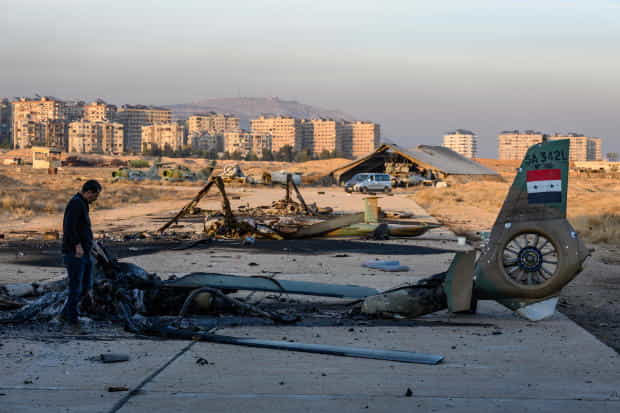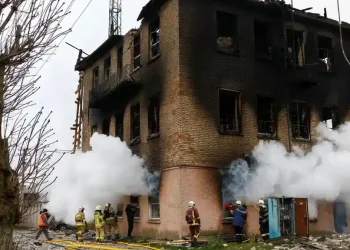Israeli Strikes Target Syria’s Military as Ousted Assad Decries Country’s Fall to Terrorism
Damascus, Syria – Syrian military airbase on the outskirts of Damascus on Monday, revealing the devastation caused by Israeli airstrikes. Israel has stated its intent to destroy weapons and military hardware accumulated by the Assad regime over decades, to prevent these resources from falling into the hands of extremists.
Since Bashar al-Assad fled Syria for Russia earlier this month—forced out by a surprise rebel offensive after years of civil war—Israeli airstrikes have relentlessly targeted Syria’s military infrastructure. Assad’s departure marked the end of a decade-long conflict, which, until recently, seemed to have reached a deadlock.
Massive Strikes on Syrian Military Sites
The damage inflicted on Assad’s forces has been immense. One overnight strike in the coastal city of Tartus, home to Russia’s naval base, was so powerful it registered on the Richter scale as the equivalent of a magnitude-3 earthquake. The Russian military quickly evacuated most of its ships from Tartus after Assad’s fall, and while Russia’s Ministry of Defense is still negotiating its next steps, its forces are in flux.
Meanwhile, Israel’s military reports that it has dealt significant blows to Assad’s military arsenal. In a statement, the Israel Defense Forces (IDF) confirmed that Israeli fighter jets have destroyed “over 90% of Syria’s strategic surface-to-air missiles.” These strikes have targeted a wide range of military assets, including fighter jets, helicopters, Scud missiles, UAVs, cruise missiles, precision-guided missiles, radars, and rockets.
Rebels Take Control as Israel Launches Ground Incursion
The rapid takeover of Syria by the Hayat Tahrir al-Sham (HTS) rebel group, now the country’s de-facto rulers, has led to further Israeli incursions. IDF forces have moved past the Golan Heights into a previously demilitarized buffer zone in Syria. HTS leader Ahmed al-Sharaa criticized Israel’s military actions but emphasized his group’s focus on rebuilding the state rather than engaging in conflict with Israel. HTS, once affiliated with al-Qaeda, has distanced itself from extremism, claiming its intention to form a secular administration.
The damage to Syria’s military infrastructure has exposed deep-rooted issues of corruption and neglect. Years of mismanagement and ongoing conflict have left much of Assad’s military hardware outdated and poorly maintained. As Assad’s forces surrendered or abandoned their posts, the Syrian military’s disarray became evident.
Assad Speaks Out from Exile
In his first public statement since fleeing Syria, Assad claimed he never planned to resign and only left for Russia due to the escalating threat from rebels. He described taking refuge in the Russian-run Hmeimim airbase as the rebels closed in on Damascus. After a drone attack on the base on December 8, Assad said evacuation orders were given. He expressed sorrow over Syria’s fall into the hands of “terrorism,” but insisted he had no choice but to flee.
The statement was initially posted on the Syrian Presidency’s official Telegram channel but was quickly deleted, only to reappear on the Telegram and Facebook pages shortly after.
Focus on Assad’s Weapons Stockpiles
As the international community grapples with how to deal with HTS, both Israel and the United States remain focused on preventing Syria’s stockpiled weapons from being exploited by extremist groups. Israel’s military campaign has been one of the most aggressive airstrikes Syria has seen in years, continuing just days after Assad’s sudden departure.
Syria’s Devastated Military
Whoever ultimately gains control of Syria will inherit a fractured military infrastructure. With Assad’s forces in disarray and most of the country’s weapons in ruins, it’s clear that Israel’s strikes were aimed at weakening Syria’s defense capabilities for years to come. According to the IDF, these efforts represent a significant achievement in the region’s ongoing power dynamics.
This article was rewritten by JournosNews.com based on verified reporting from trusted sources. The content has been independently reviewed, fact-checked, and edited for accuracy, neutrality, tone, and global readability in accordance with Google News and AdSense standards.
All opinions, quotes, or statements from contributors, experts, or sourced organizations do not necessarily reflect the views of JournosNews.com. JournosNews.com maintains full editorial independence from any external funders, sponsors, or organizations.
Stay informed with JournosNews.com — your trusted source for verified global reporting and in-depth analysis. Follow us on Google News, BlueSky, and X for real-time updates.














